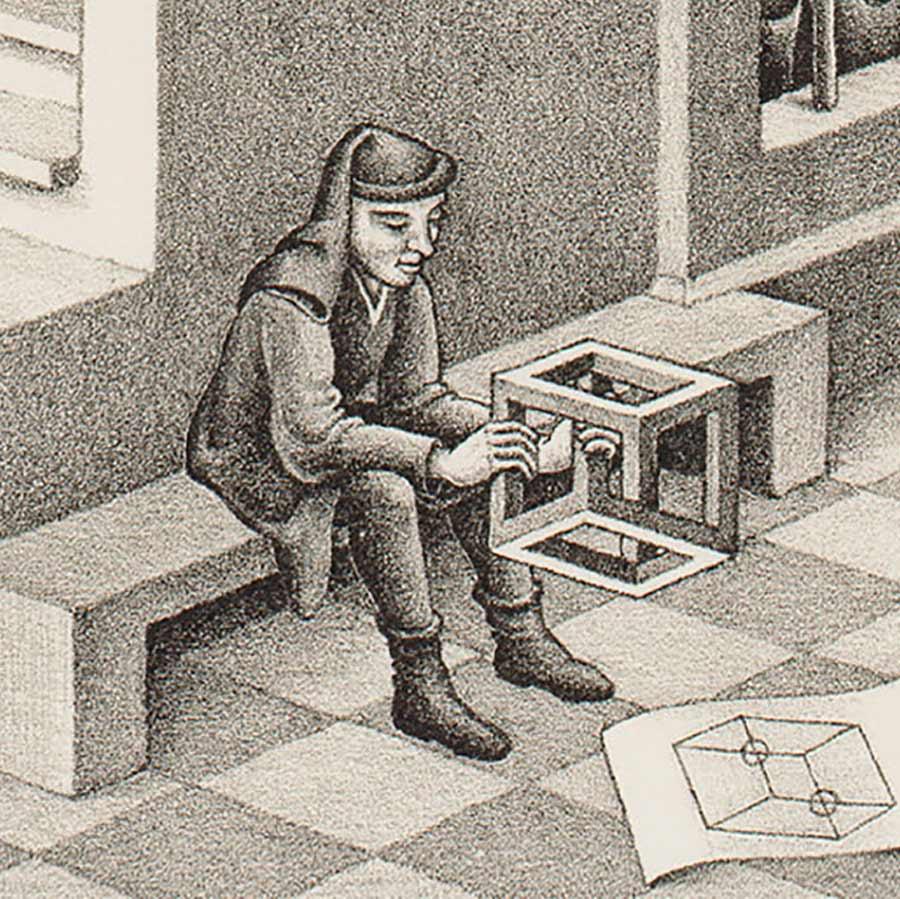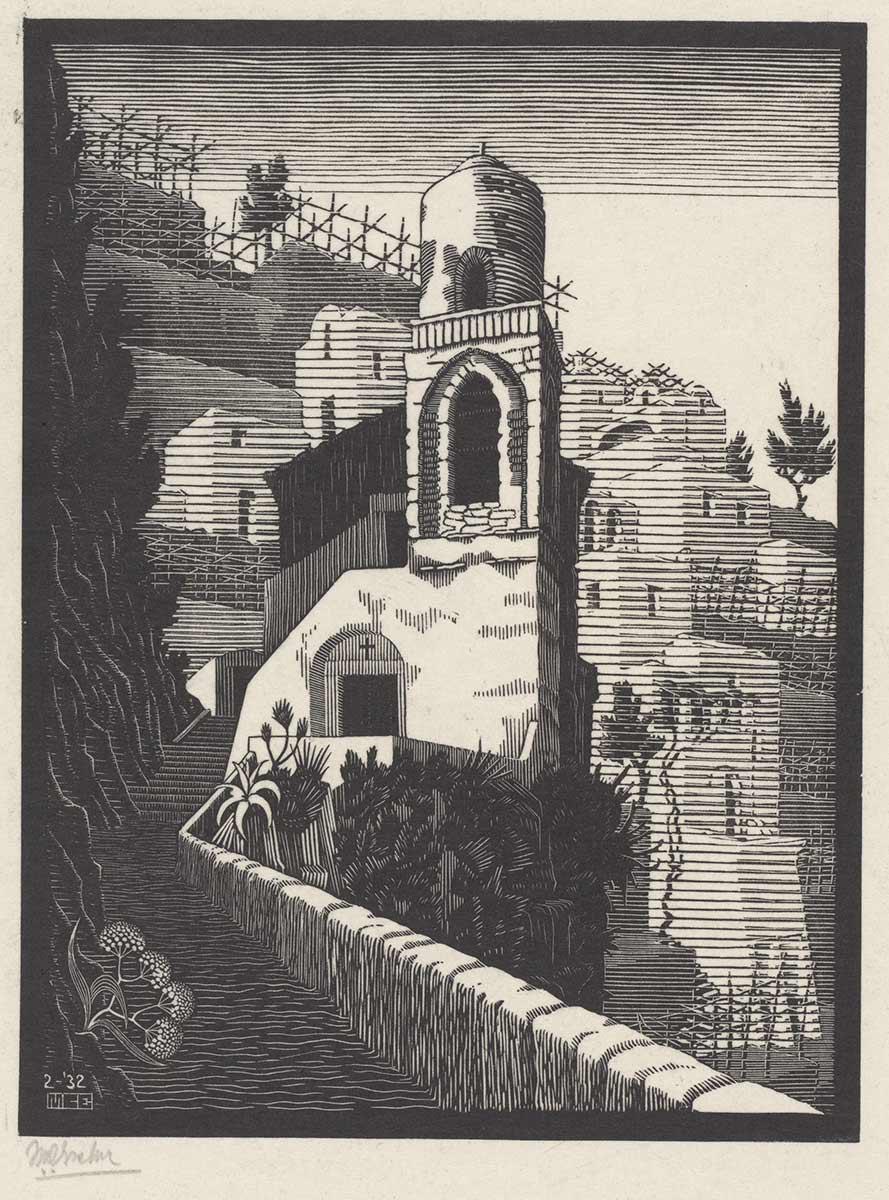

On July 29, 1961, the article How to read a painting (Adventures of the mind) by art historian Ernst Gombrich appears in the famous American magazine The Saturday Evening Post. In this article Gombrich describes a number of Escher's prints in detail. The sub-heading reads: "By visual paradoxes the artist shocks the viewer into the realization that there is more to art than meets the eye." A phrase that can clearly be related to Escher. The article generated a lot of extra interest in Escher's work.
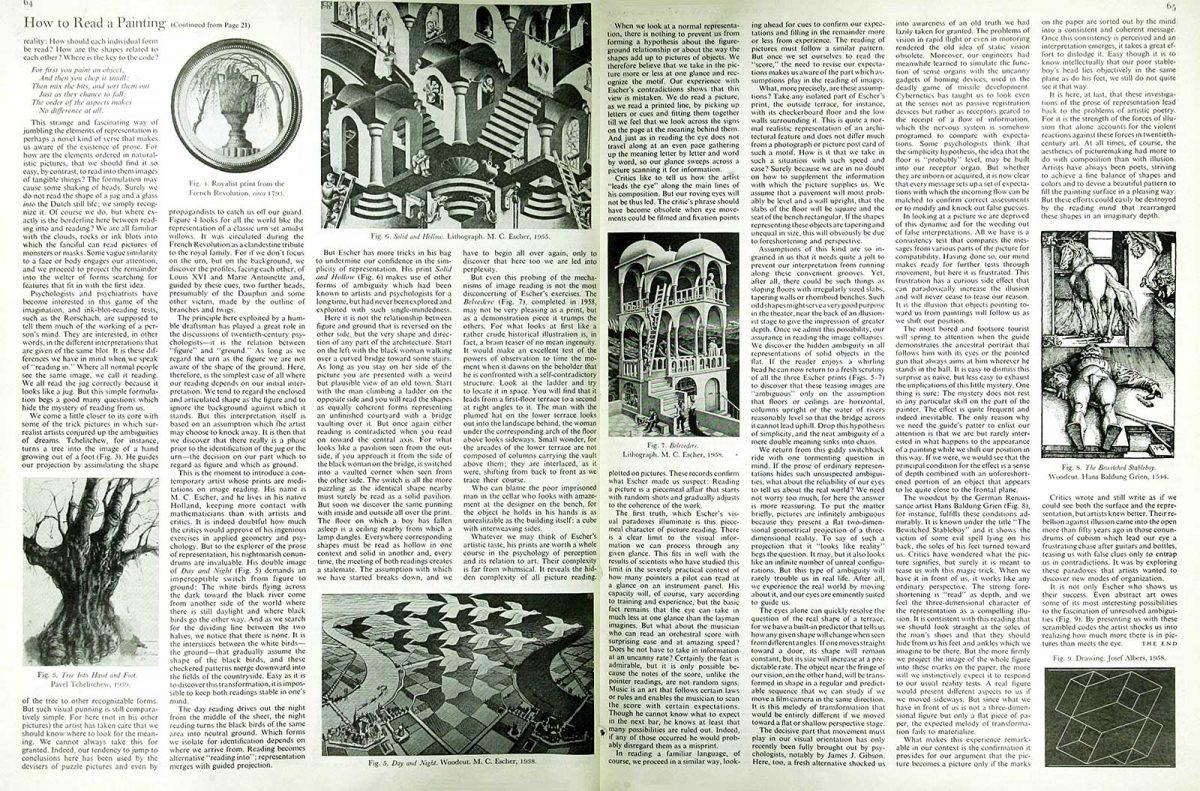
In a letter to son George and his wife Corrie, Escher writes:
I am much pleased with an article by a certain Professor E. H. Gombrich, an art historian at the University of London, in the The Saturday Evening Post of July 29, 1961, entitled How to read a painting (Adventures of the Mind). After an introduction in which he mentions several well-known artists, he explains at great length how you should look at my prints, using three reproductions by way of illustration. Not without any criticism on the (potential) aesthetic value of my work, he is appearantly quite stricken by it, for he goes on about it for more than three columns. And the publishers actually paid a hundred and forty dollars reproduction rights for those three simple prints! This too, could lead to greater things. And so I'm afraid that I'll never get away from all the correspondence and the printing of more copies of old prints. Perhaps this is just as well, for all I know I may have bled dry already and have nothing left to say. Perhaps I'll never do any more new work that's worthwile.
In this fragment, the ever doubtful side of Escher once again rears its head. He was praised by Gombrich, but the article primarily caused the feeling that from now on he would mainly reprint existing works instead of making new ones. It was a suspicion that did not come out of the blue. In 1951, three articles about him had appeared in the international magazines The Studio, Time, and Life. In 1954, Time had published another article about him. At the time, these publications had also led to a considerable increase in demand for his work.
Sir Ernst Hans Josef Gombrich (Vienna, March 30, 1909 - London, November 3, 2001) was born in Austria but has spent most of his life working in the United Kingdom. He studied art history at the University of Vienna. As a born Jew, he was forced to leave his native country when the Nazis rose to power. In 1936 he emigrated to England. There he became a research assistant at the renowned Warburg Institute in London. He remained attached to this institute until his retirement. He was director there between 1959 and 1976. Gombrich had the gift of explaining difficult subjects in a simple, clear way. He was therefore read by both laymen and specialists. His most famous publication is the book The Story of Art from 1950. Millions of copies of the book have been sold and it has been translated into thirty languages. The book is considered one of the best and most accessible histories of the visual arts. Gombrich was knighted in 1972. In addition, he has received many other awards. In 1975, for example, he received the Erasmus Prize from Dutch Prince Bernhard. He received it together with designer Willem Sandberg, former director of the Stedelijk Museum in Amsterdam.
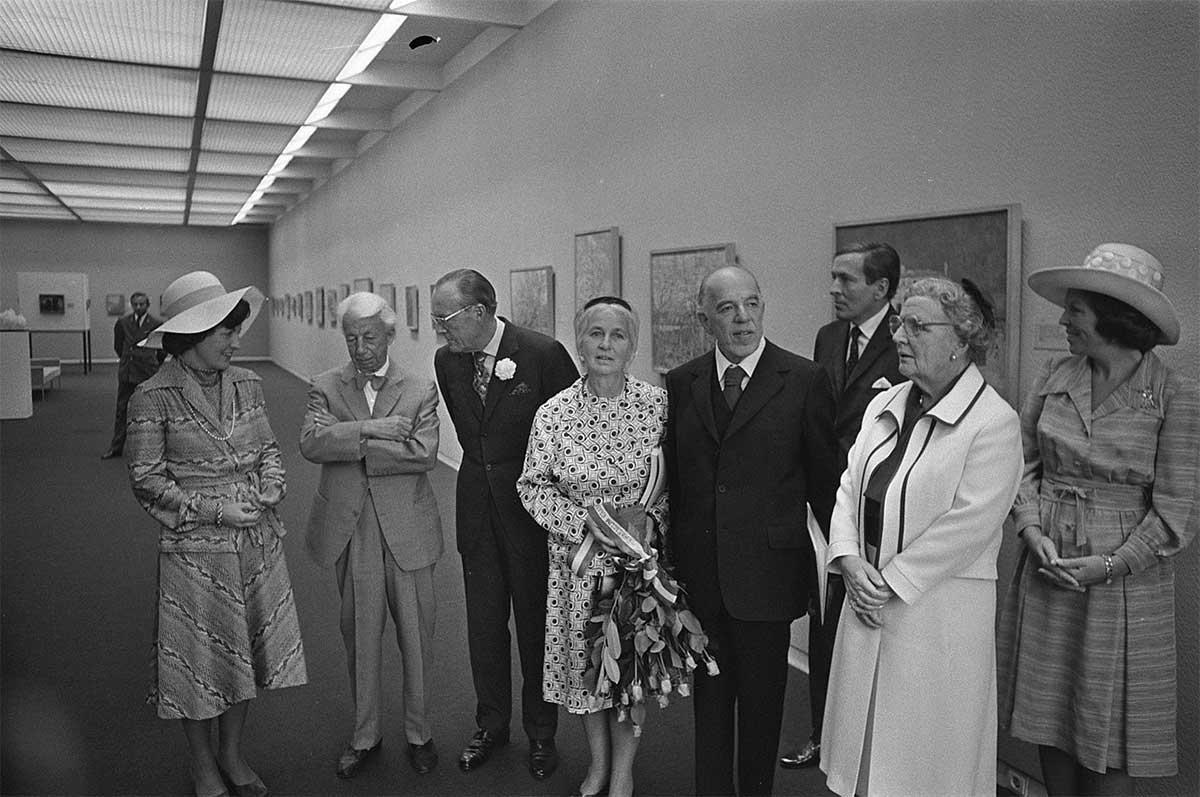
Below is the full fragment Escher from How to read a painting.
This is the moment to introduce a contemporary artist whose prints are meditations on image reading. His name is M. C. Escher, and he lives in his native Holland, keeping more contact with mathematicians than with artists and critics.
It is indeed doubtful how much the critics would approve of his ingenious exercises in applied geometry and psychology. But to the explorer of the prose of representation, his nightmarish conundrums are invaluable. His double image of Day and Night demands an imperceptible switch from figure to ground. The white birds flying across the dark towards the black river come from another side of the world where there is still daylight and where black birds go the other way. And as we search for the dividing line between the two halves, we notice that there is none. It is the interstices between the white birds - the ground - that gradually assume the shape of the black birds, and these checkered patterns merge downwards into the fields of the countryside. Easy as it, is to discover this transformation, it is impossible to keep both readings stable in one's mind. The day reading drives out the night from the middle of the sheet, the night reading turns the black birds of the same area into neutral ground. Which forms we isolate for identification depends on where we arrive from. Reading becomes an alternating 'reading into'; representation merges with guided projection. But Escher has more tricks in his bag to undermine our confidence in the simplicity of representation. His print Solid and Hollow (Convex and Concave, EK) makes use of other forms of ambiguity which had been known to artists and psychologists for a long time, but had never been explored and exploited with such single-mindedness. Here it is not the relationship between figure and ground that is reversed on the opposite side of the picture, but the very shape and direction of any part of the architecture. Start on the left with the black woman walking over a curved bridge towards some stairs. As long as you stay on her side of the picture you are presented with a weird but plausible view of an old town. Start with the man climbing a ladder on the opposite side and you will read the shapes as equally coherent forms representing an unfinished courtyard with a bridge vaulting over it. But once again either reading is contradicted when you read on towards the central axis.
For what looks like a pavilion seen from the outside if you approach it from the side of the black woman on the bridge, is switched into a vaulted corner when seen from the other side. The switch is all the more puzzling as the identical shape nearby must surely be read as a solid pavilion. But soon we discover the same punning with inside and outside all over the print. The floor on which a boy has fallen asleep is a ceiling nearby from which a lamp dangles. Everywhere corresponding shapes must be read as hollow in one context and solid in another and, every time, the meeting of both readings creates a stalemate. The assumption with which we have started breaks down, and we have to begin all over again, only to discover that here too we are led into perplexity.But even this probing of the mechanisms of image reading is not the most disconcerting of Escher's exercises. The Belvedere, completed in 1958, may not be very pleasing as a print, but as a demonstration piece it trumps the others. For what looks at first like a rather crude historical illustration is, in fact, a brain teaser of no mean ingenuity. It would make an excellent test of the powers of observation to time the moment when it dawns on the beholder that he is confronted with a self-contradictory structure. Look at the ladder and try to locate it in space. You will find that it leads from a first-floor terrace to a second at right angles to it. The man with the plumed hat on the lower terrace looks out into the landscape behind, the woman under the corresponding arch of the floor above looks sideways. Small wonder, for the arcades of the lower terrace are not composed of columns carrying the vault above them; they are interlaced, as it were, shifting from back to front as we trace their course. Who can blame the poor imprisoned man in the cellar who looks with amazement at the designer on the bench, for the object he holds in his hands is as unrealizable as the building itself: a cube with interweaving sides. Whatever we may think of Escher's artistic taste, his prints are worth a whole course in the psychology of perception and its relation to art. Their complexity is far from whimsical. It reveals the hidden complexity of all picture reading. What all these prints have in common is that they compel us to adopt an initial assumption that cannot be sustained as we try to follow it through. The perplexity that ensues suggests that this is an unusual experience. When we look at a normal representation, there is nothing to prevent us from forming a hypothesis about the figure-ground relationship or about the way the shapes add up to pictures of objects. We therefore believe that we take in the picture more or less at one glance and recognize the motif. Our experience with Escher's contradiction shows that this account is inadequate. We read a picture, as we read a printed line, by picking up letters or cues and fitting them together till we feel that we look across the signs on the page at the meaning behind them. And just as in reading the eye does not travel along at an even pace gathering up the meaning letter by letter and word by word, so our glance sweeps across a picture scanning it for information. Critics like to tell us how the artist 'leads the eye' along the main lines of his composition. But our roving eyes will not be thus led. The critic's phrase should have become obsolete when eye movements could be filmed and fixation points plotted on pictures. These records confirm what Escher made us suspect: reading a picture is a piecemeal affair that starts with random shots and these are followed by the search for a coherent whole. If that sounds a little abstract let us remember what we would do if we had to 'read' a statue blindfolded. Our first groping for information would be quite hit and miss. We would just try to find contact with the object and moving up and down we would try to seize on an identifiable feature, the nose, the arms or the breast. From that moment our movements would become more purposeful; if that is the nose, the eyes must be somewhere there and they will guide us towards the ears, etc. Sometimes our expectation would be confirmed, often we might have to revise it; our first guess, for instance, may be that the head will be directly over the feet but we may quickly discover that the statue is not standing but sitting or striding. What may take many minutes in this predicament may take less than seconds with the help of the eyes. But however unlike the two processes may be in our experience, their logic is similar. The eye, like the groping hand, scans the page, and the cues or messages it elicits are used by the questioning mind to narrow down our uncertainties. Every piece of information that reaches us through the senses can be thus used to answer a further question and remove a further doubt. The first truth, which Escher's visual paradoxes illuminate, is this piecemeal character of picture reading. There is a clear limit to the visual information we can assimilate in any given glance. This fits in well with the results of scientists who have studied this limit in the severely practical context of how many pointers a pilot can read at a glance on an instrument panel. His capacity will, of course, vary according to training and experience but the basic fact remains that the eye can take in much less at one glance than the layman imagines. But what about the musician who can read an orchestral score with surprising ease and at amazing speed? Does he not have to take in information at an uncanny rate? Certainly the feat is admirable, but it is only possible because the notes of the score, unlike the pointer readings, are not unconnected signs. Music is an art that follows certain laws or rules which enable the musician to scan the score with certain expectations. Though he cannot know what to expect in the next bar, he knows at least that many possibilities are ruled out. Indeed, if any of those occurred he would probably disregard it as a misprint. In reading a familiar language, of course, we proceed in a similar way, looking ahead for cues to confirm our expectations and filling in the remainder more or less from experience. The reading of pictures must follow a similar pattern. But once we set out to discover how we read the 'score', in particular how we have to revise our expectations, we become aware of the part which assumptions play in the reading of images.
What, more precisely, are these assumptions? Take any isolated part of Escher's Belvedere, the outside terrace, for instance, with its checkerboard floor and the low walls surrounding it. This is quite a normal realistic representation of an architectural feature and does not differ much from a photograph or picture post card of such a motif. How is it that we take in such a situation with such speed and ease? Surely because we are in no doubt about how to supplement the information with which the picture supplies us. We assume that a pavement will most probably be level and a wall upright, that the slabs of the floor will be square and the seat of the bench rectangular. If the shapes representing these objects are tapering and unequal in size, this will obviously be due to foreshortening and perspective. Assumptions of this kind are so ingrained in us that it needs quite a jolt to prevent our interpretation from running along these convenient grooves. Yet, after all, there could be such things as sloping floors with irregularly sized slabs, tapering walls or rhomboid benches. Such odd shapes might serve a very good purpose in the theatre, near the back of an illusionist stage to give the impression of greater depth. Once we admit this possibility, our assurance in reading the image collapses. We discover the hidden ambiguity in all representations of solid objects in the flat. If the reader enjoys a whirling head he can now return to a fresh scrutiny of all the three Escher prints (Figs. G, H, I) to discover that these teasing images are 'ambiguous' only on the assumption that floors or ceilings are horizontal, columns upright or the water of rivers reasonably level so that the bridge across it cannot lead uphill. Drop these hypotheses, and the neat ambiguity of a mere double meaning sinks into chaos. We return from this giddy switchback ride with one tormenting question in mind. If the prose of ordinary representations hides such unsuspected ambiguities, what about the reliability of our eyes for telling us about the real world? We need not worry too much, for here the answer is more reassuring. To put the matter briefly, pictures are infinitely ambiguous because they present a flat two-dimensional geometrical projection of a three-dimensional reality. To say of such a projection that it 'looks like reality' begs the question. It may, but it also looks like an infinite number of possible, if improbable, configurations. But this type of ambiguity will rarely trouble us in real life. After all, we experience the real world by moving about it, and our eyes are eminently suited to guide us. The eyes alone can quickly resolve the question of the real shape of a terrace, for we have a built-in predictor that tells us how any given shape will change when seen from different angles. If one moves straight towards a door, its shape will remain constant, but its size will increase at a predictable rate. The object near the fringe of our vision, on the other hand, will be transformed in shape in a regular and predictable sequence that we can study if we move a film camera in the same direction. It is this melody of transformation that would be entirely different if we moved towards a flat or shallow perspective stage.
More Escher today

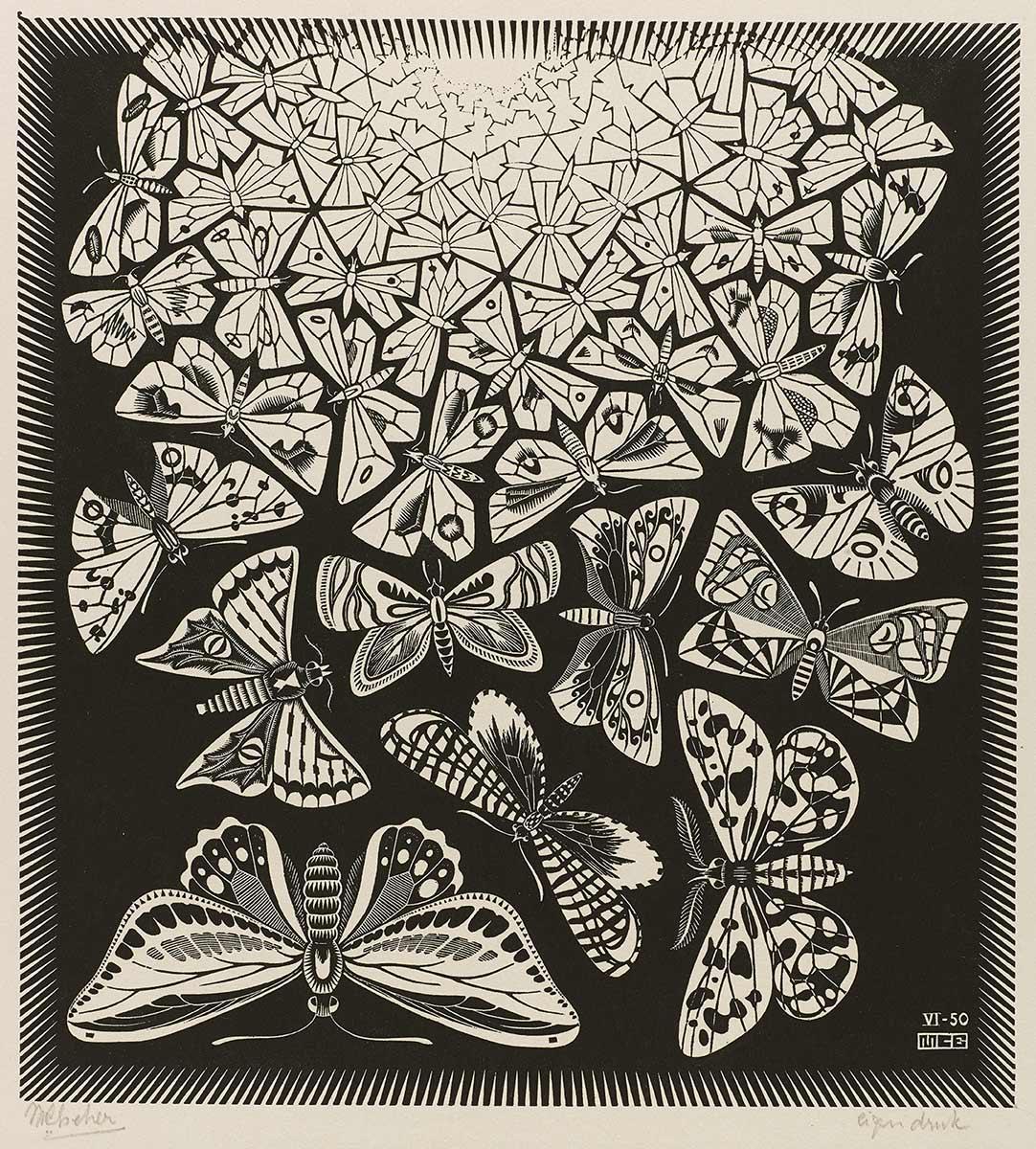
Butterflies
